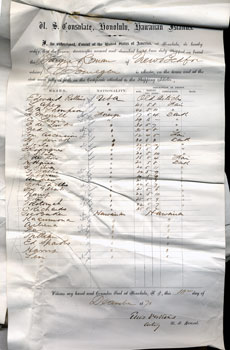Thrown Together
Once at sea, crew members of color found opportunities for mixing on whaling ships that were not available on land. The close proximity of diverse men who were at sea for months at a time led to interracial and cross-cultural exchanges that would not have occurred on shore. One white sailor recalled dancing the cotillion with another sailor during a gam; "I was lady to a stout negro—who laughed till he was hoarse and we all laughed and sang." Another white crew member who complained about the "jabber and chatter" of Portuguese sailors found that months of close quarters created a grudging acceptance; "We had endured the same hardships, faced the same dangers, suffered together, and stood night-watches together; and, although I did not regret that the tie of our fellowship was [ultimately] broken, I sincerely wished them well."
The lay system of payment that gave crew members a percentage of the voyage’s profit united men behind the common goal of a successful voyage. When individuals from diverse backgrounds worked and lived alongside each other in crowded quarters, seamen gave grudging respect to those who were particularly skilled or brave. Racial prejudice and nativist sentiments continued to exist, but shipboard order required collaboration and squelched some of the most overtly racist behaviors.

National Archives and Records Administration